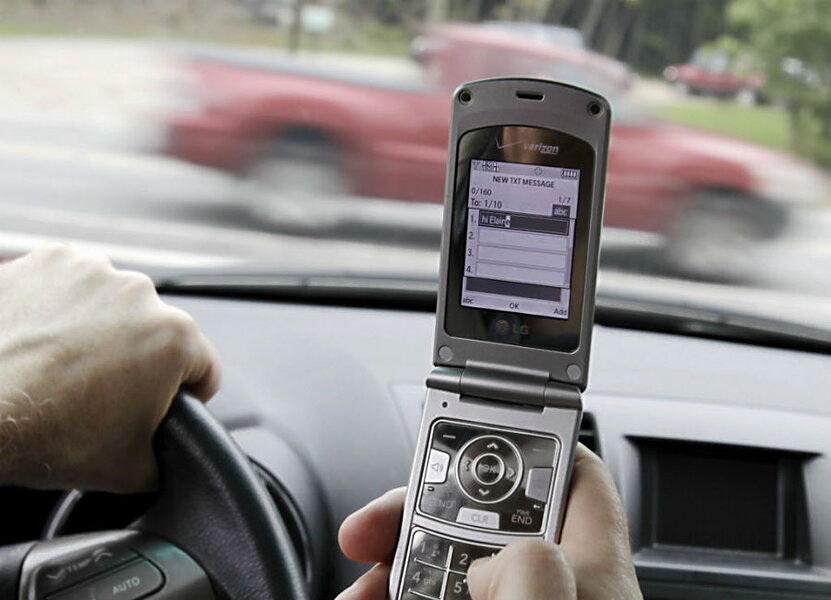Busted? 'Textalyzer' device could detect texting and driving
Loading...
Texting and driving is illegal in many states, but so far that's done little to keep people from doing it. In fact, the number of people texting – and using Facebook and Snapchat and taking selfies – behind the wheel seems to have increased.
Vehicle fatalities are up by 8 percent, the largest spike in the past 50 years. One key reason: an increase in distracted driving. According to the National Safety Council, collisions involving cell phone use have risen for three consecutive years and account for more than 25 percent of all car accidents in the United States. The Centers for Disease Control and Prevention (CDC) report that distracted drivers kill more than 3,000 people each year.
Virginia Tech researchers found that distracted driving caused nearly 70 percent of accidents, based on their analysis of cameras placed in cars.
Distraction comes in many forms, noted Tom Dingus, director of the school's Transportation Institute.
"They're looking at a cell phone, they're talking on a hand-held phone, they're tuning a radio," he told NPR.
In an effort to alleviate the problem, New York lawmakers have decided to treat texting and driving like drinking and driving – and with that comes the Textalyzer. State Senator Terrence Murphy (R) and Assemblyman Felix Ortiz (D) have introduced a bill, known as Evan's Law, which would allow police officers to use Textalyzer devices, similar to how they currently use breathalyzers.
At the scene of an accident, the Textalyzer would allow a police officer to check drivers' phones for recent activity in order to determine whether they were texting, emailing, taking selfies, or doing anything else that's prohibited under New York laws, which forbid using a phone with your hand (versus hands-free technology). Those who refuse to let officers test their phones for activity could risk driver's license suspension, akin to refusing a breathalyzer.
"We need something on the books where people's behavior can change," Mr. Ortiz said, according to The New York Times. The assemblyman hopes the legislation could scare drivers off from responding to a text or call until they've stopped the car.
The Textalyzer would not provide access to the contents of emails or text messages, a major privacy concern facing the proposed legislation. Many privacy advocates, however, worry that the device would be used to sidestep the paperwork currently required to acquire a subpoena or warrant to search a phone.
Yet some states, including North Dakota and Minnesota, are debating whether refusing even a breathalyzer should land drivers in jail. Critics argue that breathalyzers violate the Fourth Amendment, prohibiting unreasonable searches and seizures, and that police should have warrants to use them. Similar arguments could apply to the Textalyzer.
Ben Lieberman of Hudson Valley, New York, proposed the idea of a Textalyzer after his 19-year-old son Evan died from injuries following a car accident in 2011. Evan was wearing a seatbelt in the backseat of the car when its driver drifted over the yellow lines on the road and collided with oncoming traffic.
Mr. Lieberman was surprised police didn't investigate the driver's cell phone, he told NPR. "The driver said he fell asleep at the wheel," he said. "But when I finally got the cell phone records six agonizing months later, I saw texting throughout the drive and near the collision," he said.
The Textalyzer isn't the only proposed solution for distracted driving. Navdy, a startup in San Francisco, announced a new heads-up display (HUD) product that syncs a driver's smartphone with the car to project messages on the windshield.
Another app called SafeTexting R for iPhone, or SafeTexting AR for Android and Blackberry, uses cell tower change technology to display a "Please Don't Text and Drive" message when drivers try to use their phones. Through the app, drivers can sign the Safe Texting Pledge and upload photos to the "Crash Gallery," "Caught You Texting Gallery," and "Safety Event Galleries."
Distracted driving still isn't treated as seriously as drunk driving, said Candace Lightner, founder of Mothers Against Drunk Driving, in an interview with the New York Times.
"It needs to be," she said.







